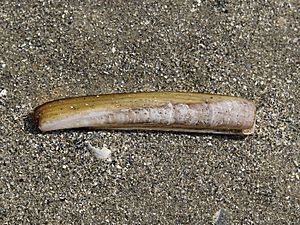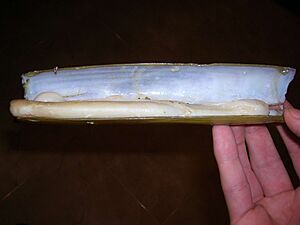Atlantic jackknife clam facts for kids
Quick facts for kids Atlantic jackknife clam |
|
|---|---|
 |
|
| Empty shell of Ensis leei | |
| Scientific classification |
The Atlantic jackknife clam, also known as the bamboo clam or American jackknife clam, is a type of large bivalve mollusc. This means it's a sea creature with a shell made of two parts, like a clam or an oyster.
You can find these clams along the Atlantic coast of North America, all the way from Canada down to South Carolina. They are also found in Europe, where they were introduced by humans. People sometimes call them "razor clams" because of their shape.
Contents
Where Jackknife Clams Live
Atlantic jackknife clams make their homes in sand and mud. They live in areas called the intertidal zone or subtidal zones. The intertidal zone is the part of the beach that is covered by water at high tide and exposed at low tide. Subtidal zones are always under water.
These clams are often found in bays and estuaries, which are places where rivers meet the sea. Their special shell shape helps them move around easily.
How They Move and Dig
The Atlantic jackknife clam has a long, streamlined shell and a strong foot. This design helps them dig into wet sand very quickly. They can bury themselves faster than a human can dig!
These clams can also "swim" a little bit. They do this by shooting jets of water out of their shells, which pushes them through the water.
Why They Are Called "Jackknife"
The clam gets its name from its shell. The edge of the shell is very sharp, and its overall shape looks a lot like an old-fashioned straight razor. Because of their sharp shells, beachgoers need to be careful not to step on them, as it can cause an injury.
Finding and Catching Jackknife Clams
When the tide is low, you can often spot where an Atlantic jackknife clam is hiding. Look for a small, keyhole-shaped opening in the sand. If you disturb the clam, a small jet of water might squirt out of this hole as the clam starts to dig deeper.
It's tricky to catch these clams because they dig so fast. However, there's a clever trick many people use. If you pour salt on the breathing hole, the clam will try to escape the salt. It will come up out of its hole, and then you can gently grab its shell and pull it out of the ground.
Are They Eaten?
Even though they are hard to catch, Atlantic jackknife clams are considered a tasty food. In places like coastal Massachusetts, people enjoy catching them in the summer. They often use them to make clam strips at home. Some towns even have rules about how many clams a person can collect at one time.
Who Eats Jackknife Clams?
Humans are not the only ones who like to eat Atlantic jackknife clams. Other animals also hunt them.
- Birds: In North America, ring-billed gulls (a type of seagull) eat them. In Europe, the Eurasian oystercatcher (a shorebird) preys on them.
- Worms: A type of worm called the nemertean worm, specifically Cerebratulus lacteus, also hunts these clams.
Jackknife Clams in Europe
The Atlantic jackknife clam is originally from North America. However, it is now also found in northwestern Europe. It was first seen there around 1978 or 1979, in a river mouth called the Elbe estuary. In Europe, this clam is seen as an exotic species, which means it's a species that isn't naturally from that area and can sometimes cause problems for the local environment.
Inspired by Nature
The way the Atlantic jackknife clam digs has inspired scientists and engineers. A team at the Massachusetts Institute of Technology (MIT) has been studying how the clam burrows. They are using this knowledge to develop a special kind of biomimetic anchor.
A biomimetic anchor is one that copies ideas from nature. This new anchor could be used to securely hold undersea cables or even boats in place, using the clam's amazing digging technique.


